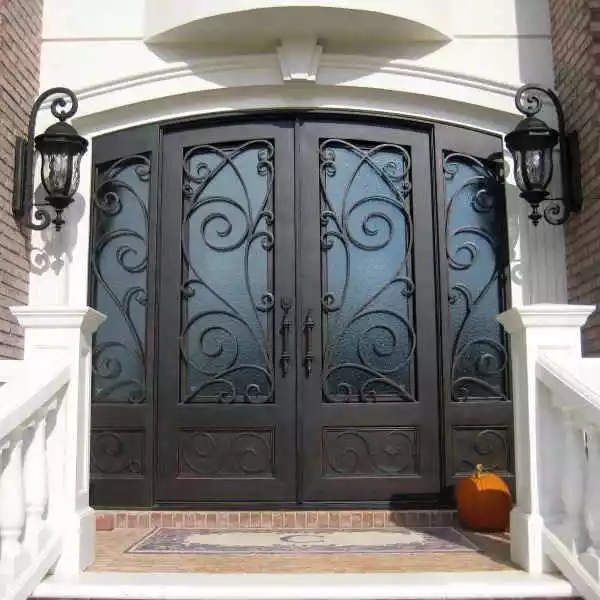Wholesale iron doors often feature a variety of design motifs, ranging from traditional to contemporary. Some common design motifs seen in wholesale iron doors include:
- Scrollwork: Intricate scrollwork designs are a classic motif in wrought iron doors. These swirling patterns can range from simple to elaborate, adding elegance and sophistication to the door’s appearance.
- Floral and Botanical Patterns: Floral and botanical motifs, such as leaves, flowers, and vines, are popular choices for adding natural beauty and organic elements to iron doors. These motifs can be stylized or realistic, depending on the desired aesthetic.
- Geometric Patterns: Geometric patterns, including squares, circles, diamonds, and triangles, are often incorporated into wholesale iron doors to create modern and contemporary looks. These patterns can be simple or complex, adding visual interest and symmetry to the design.
- Architectural Elements: Wholesale iron doors may feature architectural motifs inspired by historical styles, such as Gothic arches, Romanesque columns, or Art Deco motifs. These elements evoke a sense of grandeur and timelessness, adding character to the door’s design.
- Abstract Designs: Abstract motifs, such as swirls, waves, and asymmetrical patterns,wholesale iron doors offer a more contemporary and artistic approach to iron door design. These designs can be bold and expressive, making a statement in modern architectural settings.
- Animal and Figural Motifs: Animal and figural motifs, such as animals, birds, or human figures, can add whimsy and personality to iron doors. These motifs are often used in decorative accents or as focal points in the design.
- Celtic and Tribal Patterns: Celtic knots, tribal symbols, and other cultural motifs can be incorporated into iron door designs to reflect heritage, tradition, or personal significance. These motifs often feature intricate interlocking patterns and symbolism.
- Fleur-de-lis: The fleur-de-lis is a stylized lily or iris flower motif that has historical significance and is commonly used in decorative ironwork. It adds a touch of elegance and sophistication to iron doors, particularly in traditional and French-inspired designs.
- Border and Frame Designs: Border and frame motifs, such as borders of scrolls, leaves, or geometric patterns, are often used to outline the edges of wholesale iron doors and create a cohesive and finished look.
- Custom and Personalized Designs: Many wholesale iron door manufacturers offer custom design services, allowing customers to create unique and personalized motifs tailored to their preferences, architectural style, or branding.
These design motifs can be combined, modified, or customized to create wholesale iron doors that suit a wide range of architectural styles, preferences, and aesthetic tastes.
How do iron door fare in terms of resistance to pests and insects?
Iron doors generally fare very well in terms of resistance to pests and insects. Here’s why:
- Material Composition: Iron is a dense and solid material that pests and insects cannot penetrate. Unlike wood, which can be susceptible to damage and infestation by termites, carpenter ants, and other pests, iron provides a sturdy barrier that insects cannot easily breach.
- Lack of Food Source: Pests and insects are attracted to materials that serve as food sources or nesting sites. Iron does not provide any sustenance for pests, making it unattractive to them. Additionally, the smooth surface of iron doors does not offer the same opportunities for nesting or burrowing as other materials.
- No Gaps or Openings: Iron doors are typically manufactured to be solid and seamless, without gaps or openings that could allow pests or insects to enter. This means there are fewer entry points for pests to exploit, further reducing the risk of infestation.
- Durability: Iron doors are highly durable and resistant to damage from environmental factors such as moisture, iron door manufacturers rot, and decay. This durability helps maintain the integrity of the door structure, preventing the formation of cracks or holes that could potentially provide access points for pests.
- Regular Maintenance: While iron doors are inherently resistant to pests and insects, it’s still essential to perform regular maintenance to ensure their continued effectiveness. This may include cleaning the surface to remove debris or buildup that could attract pests, as well as inspecting for any signs of damage or wear that may need repair.
Overall, iron doors offer excellent resistance to pests and insects due to their material composition, lack of food sources, seamless construction, and durability. This makes them a reliable choice for homeowners looking to minimize the risk of pest infestations while enhancing the security and aesthetics of their property.
